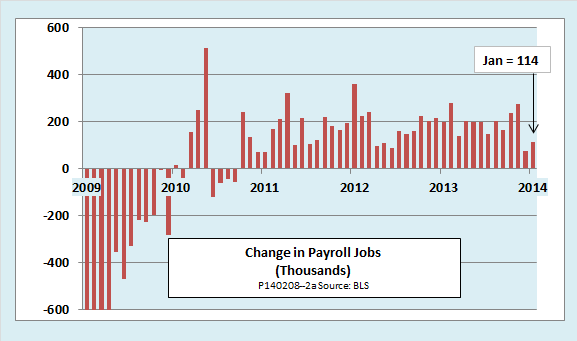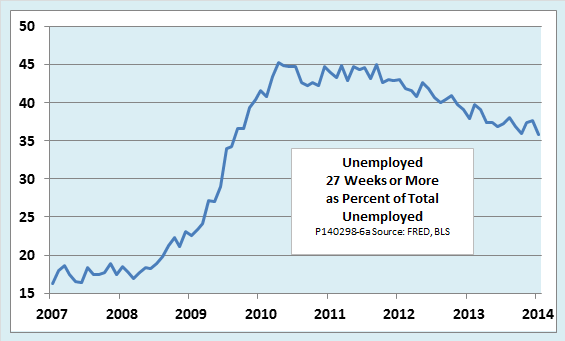Although the news that the U.S. economy generated just 113,000 new payroll jobs in January 2014 disappointed many observers, the latest report from the BLS on the employment situation was fundamentally positive. That was evident not only from the 6.6 percent unemployment rate, down nearly half a percentage point over the last two months, but also from many underlying measures of employment stress—part-time work, long-term joblessness, and others.
Let’s start with the bad news and get it out of the way. January’s 113,000 new payroll jobs marked the second month in a row of low job growth. December’s even lower figure was revised up by just 1,000 jobs to 75,000. Even here, though, the news was not all bad. The relatively robust November job gain was revised up from a first-reported 203,000 to 274,000. In addition, the BLS rebenchmarked its data, as it does each year, to reflect a more comprehensive count of payrolls. The rebenchmarking increased job growth for the year by 136,000, bringing the total gain to 2,322,000. The following chart shows the rebenchmarked data.
Data from the household survey were considerably more upbeat than those from the establishment survey on which the data for payroll jobs are based. The two surveys differ in several ways. Among other things, the household survey includes self-employed and farm workers. It also counts workers, not jobs; one worker with two jobs gets double-counted in the establishment survey.
The household survey showed strong improvement in the labor market—630,000 more employed workers and 115,000 unemployed than in December. The unemployment rate fell to 6.6 percent, the lowest in more than five years. In contrast to December, when a decrease in the unemployment rate was largely attributed to a decrease in the labor force, the number of people working or looking for work rose by 523,000. Both the labor force participation rate and the employment-population ratio increased.
In addition to the standard unemployment rate, the BLS reports a broader measure of labor market stress. That indicator, known as U-6, includes discouraged workers and involuntary part-time workers as well as the officially unemployed. U-6 decreased sharply in January to 12.7 percent of the labor force, its lowest level in more than five years. The next chart shows both standard and broad unemployment.
The drop in U-6 was caused, in part, by a sharp decrease in the number of people involuntarily working part-time, or, to use the official terminology, working part-time “for economic reasons.” Those include people whose hours have been cut because of slack business conditions and people who would prefer a full-time job but can only find part-time work. As the next chart shows, involuntary part-time workers decreased from 5 percent of the labor force to 4.7 percent, the lowest since late 2008. At the same time, there was an increase in the number of people voluntarily working part-time. In all, nearly three-quarters of people who worked part-time were doing so for “noneconomic reasons,” such as childcare, family obligations, school, or retirement. (For more details on the evolution of voluntary and involuntary part-time work in the United States, see this recent post.) 
Finally, the percentage of the unemployed who had been out of work for 27 weeks or longer also dropped to a new low for the recovery. Long-term unemployment has been unusually high throughout the recession. The January figures represent a welcome resumption of a downtrend that had been interrupted in November and December. The median and mean duration of unemployment both decreased in the month. 
On the whole, then, the employment situation showed continuing improvement in January. Despite a disappointing number of new headline jobs, several data series hit new lows for the recovery, including both the standard and broad unemployment rates, involuntary part-time work, and long-term unemployment. The civilian labor force, the labor force participation rate, and the employment-population ratio all increased. These developments point to continuing expansion of the economy at the beginning of 2014.
Original post
- English (UK)
- English (India)
- English (Canada)
- English (Australia)
- English (South Africa)
- English (Philippines)
- English (Nigeria)
- Deutsch
- Español (España)
- Español (México)
- Français
- Italiano
- Nederlands
- Português (Portugal)
- Polski
- Português (Brasil)
- Русский
- Türkçe
- العربية
- Ελληνικά
- Svenska
- Suomi
- עברית
- 日本語
- 한국어
- 简体中文
- 繁體中文
- Bahasa Indonesia
- Bahasa Melayu
- ไทย
- Tiếng Việt
- हिंदी
Forget Weak Payroll Numbers, January’s Employment Report Was Positive
Published 02/08/2014, 02:03 PM
Updated 07/09/2023, 06:31 AM
Forget Weak Payroll Numbers, January’s Employment Report Was Positive
3rd party Ad. Not an offer or recommendation by Investing.com. See disclosure here or
remove ads
.
Latest comments
Install Our App
Risk Disclosure: Trading in financial instruments and/or cryptocurrencies involves high risks including the risk of losing some, or all, of your investment amount, and may not be suitable for all investors. Prices of cryptocurrencies are extremely volatile and may be affected by external factors such as financial, regulatory or political events. Trading on margin increases the financial risks.
Before deciding to trade in financial instrument or cryptocurrencies you should be fully informed of the risks and costs associated with trading the financial markets, carefully consider your investment objectives, level of experience, and risk appetite, and seek professional advice where needed.
Fusion Media would like to remind you that the data contained in this website is not necessarily real-time nor accurate. The data and prices on the website are not necessarily provided by any market or exchange, but may be provided by market makers, and so prices may not be accurate and may differ from the actual price at any given market, meaning prices are indicative and not appropriate for trading purposes. Fusion Media and any provider of the data contained in this website will not accept liability for any loss or damage as a result of your trading, or your reliance on the information contained within this website.
It is prohibited to use, store, reproduce, display, modify, transmit or distribute the data contained in this website without the explicit prior written permission of Fusion Media and/or the data provider. All intellectual property rights are reserved by the providers and/or the exchange providing the data contained in this website.
Fusion Media may be compensated by the advertisers that appear on the website, based on your interaction with the advertisements or advertisers.
Before deciding to trade in financial instrument or cryptocurrencies you should be fully informed of the risks and costs associated with trading the financial markets, carefully consider your investment objectives, level of experience, and risk appetite, and seek professional advice where needed.
Fusion Media would like to remind you that the data contained in this website is not necessarily real-time nor accurate. The data and prices on the website are not necessarily provided by any market or exchange, but may be provided by market makers, and so prices may not be accurate and may differ from the actual price at any given market, meaning prices are indicative and not appropriate for trading purposes. Fusion Media and any provider of the data contained in this website will not accept liability for any loss or damage as a result of your trading, or your reliance on the information contained within this website.
It is prohibited to use, store, reproduce, display, modify, transmit or distribute the data contained in this website without the explicit prior written permission of Fusion Media and/or the data provider. All intellectual property rights are reserved by the providers and/or the exchange providing the data contained in this website.
Fusion Media may be compensated by the advertisers that appear on the website, based on your interaction with the advertisements or advertisers.
© 2007-2024 - Fusion Media Limited. All Rights Reserved.
